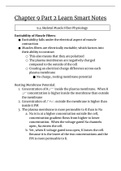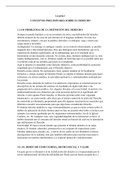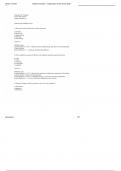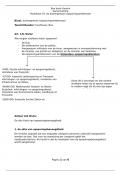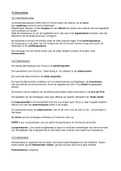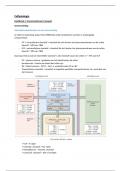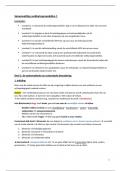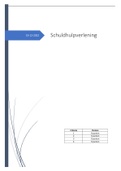Inhoudsopgave
1. Pathofysiologie van infectieziekten............................................................................................................. 4
1.1. Definities........................................................................................................................................................4
1.2. Pathofysiologie..............................................................................................................................................4
1.3. Microbiële virulentie......................................................................................................................................4
1.4. Pathogenese van infecties.............................................................................................................................5
1.5. Afweermechanismen van de gastheer..........................................................................................................6
1.5.1. Natuurlijke of aangeboren weerstand....................................................................................................6
2. Epidemiologie van infectieziekten.............................................................................................................. 8
2.1. Beschrijvende epidemiologie.........................................................................................................................8
2.2. Surveillance....................................................................................................................................................9
3. Klinische aspecten van infectieziekten en aanvullende diagnostiek.............................................................9
3.1. Klinische aspecten..........................................................................................................................................9
3.2. Koorts.............................................................................................................................................................9
3.3. Aanvullende diagnostiek..............................................................................................................................11
4. Sepsis....................................................................................................................................................... 13
4.1. Definities......................................................................................................................................................13
4.2. Etiologie.......................................................................................................................................................14
4.3. Pathogenese................................................................................................................................................14
4.4. Prognose......................................................................................................................................................15
4.5. Behandeling.................................................................................................................................................15
4.6. Bijzondere gevallen van sepsis....................................................................................................................16
5. Koorts bij terugkeer uit de (sub)tropen..................................................................................................... 17
5.1. Elementen bijdragend in differentieel diagnose..........................................................................................17
5.2. Dengue/ knokkelkoorts................................................................................................................................18
5.3. Malaria........................................................................................................................................................20
5.4. Rickettsiosen: African tick bite fever............................................................................................................22
5.5. Buiktyfus......................................................................................................................................................22
5.6. Katayama koorts = acute schistosomiase....................................................................................................23
5.7. Chikungunya................................................................................................................................................23
5.8. Virale hemorrhagische koortsen..................................................................................................................24
5.9. Opgepast!....................................................................................................................................................24
6. Infectieuze diarree................................................................................................................................... 25
6.1. Etiologie en pathogenese............................................................................................................................25
, 6.2. Symptomen en diagnose.............................................................................................................................25
6.3. Behandeling.................................................................................................................................................26
6.4. Antibiotica-geassocieerde diarree...............................................................................................................27
6.5. Parasitaire diarree.......................................................................................................................................28
7. HIV/AIDS.................................................................................................................................................. 29
7.1. Epidemiologie..............................................................................................................................................29
7.2. Transmissie..................................................................................................................................................29
7.3. Klinisch verloop............................................................................................................................................30
7.4. Initiële evaluatie..........................................................................................................................................31
7.5. Klinische classificatie: 3 klinische categorieën (CDC classificatie)...............................................................31
7.6. Behandeling en opvolging van de HIV patiënt............................................................................................32
7.7. Preventie bij zorgverleners..........................................................................................................................34
7.8. Preventie bij niet-professionele risico’s........................................................................................................35
8. Seksueel Overdraagbare Aandoeningen (SOA)..........................................................................................36
8.1. Syphilis.........................................................................................................................................................36
8.2. Gonorree......................................................................................................................................................37
8.3. Niet-gonokokken urethritis (NGU)...............................................................................................................37
8.4. Herpes genitalis...........................................................................................................................................38
8.5. Condylomata accuminata (=genitale wratten)............................................................................................38
8.6. Algemene opmerking bij SOA......................................................................................................................38
9. Capita selecta bacteriële infecties............................................................................................................. 39
9.1. Buiktyfus......................................................................................................................................................39
9.2. Non-typhi salmonellosen.............................................................................................................................39
9.3. Leptospirose.................................................................................................................................................40
9.4. Kattenkrabziekte..........................................................................................................................................40
9.5. Bijtwonden...................................................................................................................................................41
9.6. Ziekte van Lyme...........................................................................................................................................41
9.7. Tetanus (wondklem)....................................................................................................................................43
9.8. Pertussis (kinkhoest)....................................................................................................................................43
10. Capita selecta virale infecties.................................................................................................................. 45
10.1. Influenza (griep).........................................................................................................................................45
10.2. Mononucleosis infectiosa..........................................................................................................................45
10.3. Cytomegalovirus........................................................................................................................................46
10.4. Herpes simplex virus..................................................................................................................................47
10.5. Varicella zoster virus..................................................................................................................................48
Varicella (= wind – water -wijn pokken).........................................................................................................48
Zoster (=zona, gordelroos)..............................................................................................................................48
10.6. Mazelen.....................................................................................................................................................49
, 10.7. Coronavirusinfecties..................................................................................................................................49
10.7.1. Eerdere ernstige coronavirusinfecties................................................................................................49
10.7.2. COVID-19............................................................................................................................................49
11. Capita selecta fungale infecties............................................................................................................... 52
11.1. Candidase..................................................................................................................................................52
11.2. Aspergillose................................................................................................................................................53
12. Capita selecta parasitaire infecties.......................................................................................................... 55
12.1. Toxoplasmose.............................................................................................................................................55
12.2. Malaria......................................................................................................................................................55
13. Vaccinaties bij volwassenen.................................................................................................................... 56
13.1. Inleiding.....................................................................................................................................................56
13.2. Vaccins voor volwassenen.........................................................................................................................56
13.2.1. Tetanus-difterie (Td)...........................................................................................................................56
13.2.2. Influenzavaccin...................................................................................................................................56
13.2.3. Pneumokokkenvaccin.........................................................................................................................57
13.3. Basisvaccinatieschema: kinderen..............................................................................................................58
13.4. Vaccine-hesitancy en vaccinweigering......................................................................................................58
14. Rationele antimicrobiële therapie........................................................................................................... 59
14.1. Microbiologische basis van antibiotica therapie.......................................................................................59
14.2. Farmacologische basis van antimicrobiële therapie.................................................................................61
14.3. Klinische basis van antimicrobiële therapie...............................................................................................62
14.4. Antibiotic stewardship...............................................................................................................................64
,1. Pathofysiologie van infectieziekten
1.1. Definities
Infectieziekte = klinisch waarneembare toestand van schade of verandering in de normale fysiologie
vd gastheer die gepaard gaat met een ontstekingsreactie (inflammatie), veroorzaakt door besmetting
met een ziekmakend micro-organisme (MO)
Besmetting = vooraf aan infectie, maar leidt niet noodzakelijk tot infectie
Dragerschap/kolonisatie = MO handhaven en vermenigvuldigen zich op of in de gastheer, echt
zonder inflammatie of schade te veroorzaken, bv. Coagulase-negatieve stafylokok op huid, huidflora,
darmflora. Kolonisatie kan vaak nuttig zijn (kolonisatie resistentie in de darm, huid).
1.2. Pathofysiologie
Infectie = pathogeen vermogen MO (virulentie) >
afweermechanisme gastheer
Interactie tussen micro-organisme en gastheer:
Klinische beeld van een infectie is afh van:
- Ziekmakend vermogen vh MO
- Infectiefocus
- Inflammatoire reactie vd gastheer
Zowel kenmerken vd gastheer als het MO bepalen het resultaat van deze interactie, dit onderscheidt
infectiezieken van andere ziekten.
1.3. Microbiële virulentie
Obv het ziekmakend vermogen van MO (virulentie) maken we een onderscheid tussen: primair
pathogene, potentieel pathogene en opportunistische MO. Deze indeling (arbitrair!) is belangrijk
voor besmettingsroute en preventie.
Primair/obligaat pathogene MO
- Besmetting leidt vaak tot ziekte, bij grote deel van een gevoelige, maar gezonde populatie;
onmiddellijk na besmetting of veel later
- Exogene infectie, aanwezigheid in het lichaam is niet compatibel met gezondheid
- Overdraagbaar, en kan aanleiding geven tot epidemies
- Bv. Salmonella typhi, Mycobacterium tuberculosis, HIV, influenza, SARS-CoV-2, mazelen, Plasmodium
falciparum
- Preventie:
o Vermijden van blootstelling
o Eradiceren van reservoir of vector
o Vaccinatie en chemoprofylaxie
,Potentieel pathogene MO
- Besmetting leidt meestal tot kolonisatie (dragerschap)
- Infectie ontstaat bij de gastheer indien:
o Lokale of algemene voorbeschiktheid,
Bv. coagulase-negatieve stafylokokken bacteriëmie door IV-katheterinfectie.
Bv. Postoperatieve wondinfecties
Bv. Candida infecties mond/vulvovaginaal bij diabetici en patiënten met ABkuur
o MO toegang steriele lichaamscompartimenten, bv. E. Coli in urine
- Endogene infecties: door eigen koloniserende flora, Bv. commensale flora
- Preventie:
o Vermijden/corrigeren van voorbeschikkende gastheerfactoren
o Hygiëne/asepsie in de zorg
- Commensale flora kan nuttig zijn!
o Anaërobe commensale flora darm vreemde, potentieel pathogene MO kunnen
geen schade aanrichten “kolonisatieresistentie”
o Bij systemische AB majeure verstoring commensale flora (uitselectie resistente
organismen)
- Nosocomiale infecties (=verworven in het ziekenhuis)
o = koloniserende MO “nieuwe commensalen” die de patiënt verwerft tijdens
ziekenhuisopname
Agressie op gastheer + lokale/algemene voorbeschiktheid kolonisatie
ernstige infectie met MO die multiresistent zijn tegen AB
o Preventie tegen nosocomiale infecties
Vermijden van voorbeschikkende gastheerfactoren (bv. katheter, urinesonde)
Hygiëne/asepsie in de zorg
Bronisolatie
Strikte handhygiëne door zorgverleners om verspreiding te voorkomen
Opportunistische pathogene MO
- Besmetting leidt tot (voorbijgaande) kolonisatie bij gezonde personen
- Enkel infectie bij gastheer met langdurig ziekteverblijf en/of met ernstige stoornis in
humorale/cellulaire immuniteit
- Exogene infectie
- Niet overdraagbaar naar gezonden, dus geen bron van epidemies
o Wel vermijden dat voorschikte patiënt in contact komt met besmettelijke bron
o Protectieve isolatie: voorbeschikte patiënt in isolatie verpleegd
- Bv. Pneumocystis jiroveci pneumonie bij AIDS patiënt, Aspergillus pneumonie bij neutropene
patiënt na chemotherapie
1.4. Pathogenese van infecties
Infectie: MO moet virulentiefactoren tot expressie brengen + inflammatoire respons van gastheer.
Lokale infectie zonder invasie is voor een aantal MO voldoende om klachten te geven, bv. urethritis
Neisseria gonorrhoeae
Sommige infecties: systemisch karakter niet door invasie, maar door absorptie van antigenen of
exotoxine
1. Adherentie: stabiele binding van MO aan lichaamsoppervlak
2. Proliferatie van MO afscheiden van exotoxines
a. Exotoxines gaan aanleiding geven tot inflammatie en ziektesymptomen
b. Bv. tetanospasmine van Clostridium tetani, enterotoxines van E. Coli, Vibro cholerea
, Invasieve MO: verspreiding via het lymfestelsel brengt MO bij lymfeklieren en vervolgens in
de bloedbaan
1. Invasie: overschrijden huid- en mucosabarrière
2. Weerstand tegen spontane (niet-antigeenspecifieke) afweermechanismen vd gastheer
3. Uitzaaiing: verspreiding in het lichaam – oa naar het doelwitorgaan
4. Ontstekingsreactie
a. Gemedieerd door celwandbestanddelen vh MO
i. lipopolysacchariden ‘endotoxines’ van gram- bacteriën
ii. teichoinezuur en lipoteichoinezuur van gram+ bacteriën
iii. Celwandbestanddelen van fungi en parasieten
Zowel bij invasieve als niet-invasieve MO ontwikkelt de gastheer een inflammatoire respons en
immunologisch antwoord op deze microbiële agressie. Zowel microbiële factoren als het antwoord vd
gastheer zullen het ziekteverloop bepalen (ernst, genezing, chroniciteit, blijvende schade of dood).
1.5. Afweermechanismen van de gastheer
1.5.1.Natuurlijke of aangeboren weerstand
Huid en mucosa barrière
- = mechanische barrière tegen invasie
- Versterkt door:
o Microbicide secreties van talg- en zweetklieren in de huid
o Maagzuur
o Productie van mucus in de luchtwegen
o Afschilfering van huidcellen
o Motiliteit ter hoogte vd mucosae (darmperistalitiek, diurese, hoesten, mucocoliaire
klaring)
- Bescherming door commensale flora op huid en mucosa
o Verhindert adherentie en proliferatie van meer pathogene MO = “kolonisatie-
resistentie”
o Antigeen-specifiek afweermechanisme: IgA secretie voorkomen van infecties
- Stoornissen in huid- en mucosa barrière
o Bv. postoperatieve wondinfecties, IV kathetersepsis, urineweginfecties op blaassonde,
ventilator-geassocieerde pneumonie, geen normale slijmsecretie bij MUCO,…
Humorale afweermechanismen
- Niet-antigeen specifieke afweer: lactoferrine, lysosyme in lichaamsvochten en het
Complementsysteem
o Factor C3a en C5a: verhoogt vaatpermeabiliteit
o Factor C5a en B: chemotaxis
o Factor C3b: opsonisatie van MO
o Lytisch complement (factor C5-9): membrane attack complex
- Stoornis in complementsysteem recidiverende pyogene bacteriële infecties
(stafylokokken) en recidiverende meningokokkeninfecties
- Antigeen-specifieke afweer: immuunglobulines IgG en IgM
o Neutralisatie en agglutinatie van toxines
o Complementactivering
o Interferentie met adherentie (“blocking antibodies”)
o Opsonisatie
- Vaccinatie (=opwekken van antistoffen) humorale afweer preventie van infecties


